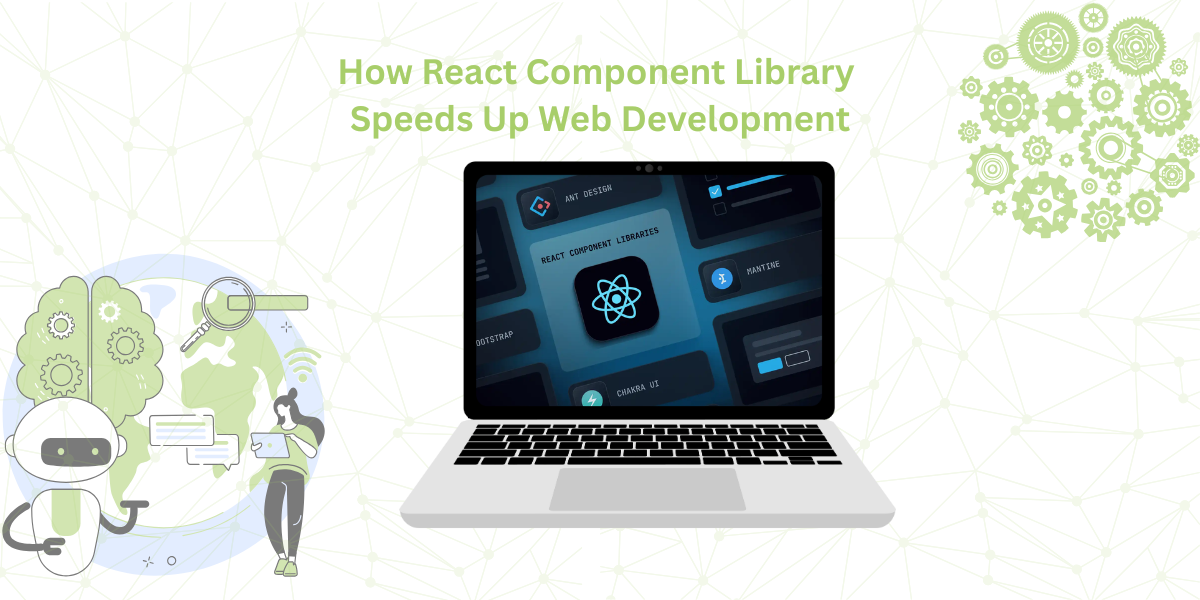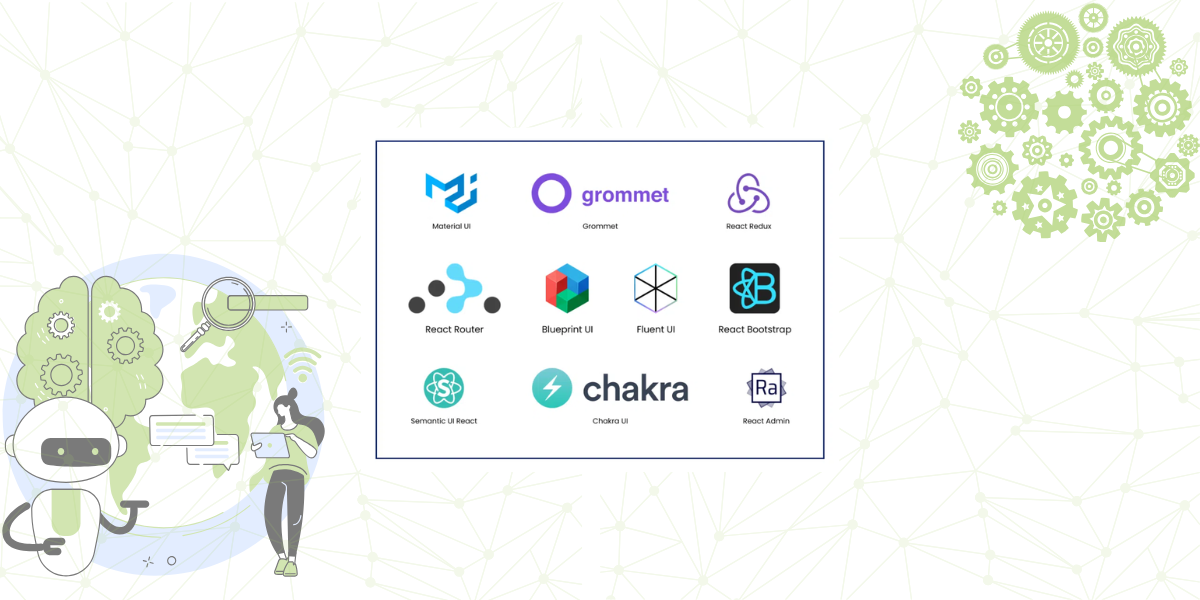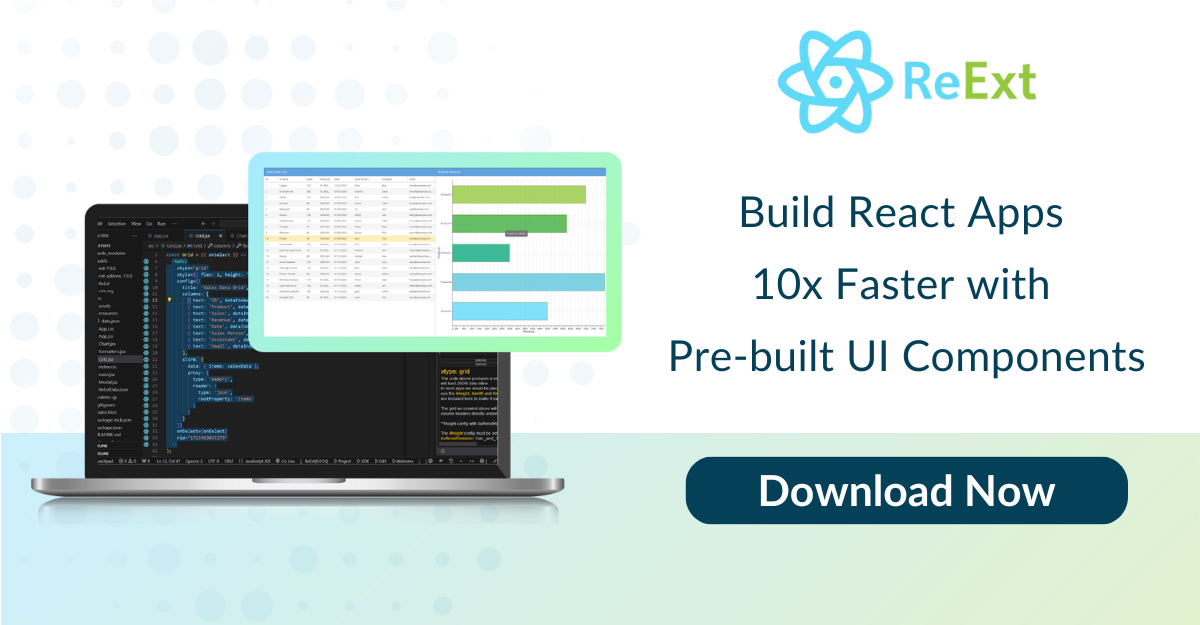How React Component Library Speeds Up Web Development
The creation of user interfaces from scratch takes a long time. It also requires repetitive work. The availability of React UI component libraries provides excellent support to development tasks. Such libraries provide ready-made customizable UI elements. These reduce both work time and necessary effort. You can achieve uniform interface designs by using a React component library. This helps avoid extensive manual development.

In this blog, we will explain how React UI component libraries optimize web development processes. To put it simply, what is React component library? It’s a collection of pre-built, reusable UI elements that help developers design consistent, responsive, and scalable web applications faster. You will learn how developers enjoy these components. You will understand how they increase your workflow. You will explore the most famous libraries: ReExt, Material-UI, Ant Design, and Chakra UI. This will help you select the perfect choice for your project.
We will also introduce the selection process for proper reusable React components libraries. It also covers component modification and performance enhancement. This guide demonstrates how these tools simplify development. They help create powerful, scalable applications with attractive visual design.
Let’s get started.
What Are React UI Component Libraries?
React UI Components libraries contain pre-made components. These are used in developing React applications. You get time savings through existing components. These include buttons, modals, navigation menus, and additional elements. You experience greater efficiency by importing pre-made elements. This lets you focus on the essential features of your app.
The libraries provide different components. These come fully designed for immediate usage. You can customize the components to your project requirements. The libraries simplify rapid development. They help create uniform and adaptable UIs.
React UI component libraries work as design consistency tools. These components allow your application to develop visual harmony. They maintain consistency across various sections of the user interface. These libraries are built to ensure accessibility and performance enhancement. The best part? These libraries eliminate the need for developers to handle such details manually.
Each well-known library has distinct features. Material-UI, Ant Design, Chakra UI, and ReExt offer different capabilities. They are suitable for enterprise-scale applications. They also help in building modern, high-performing web applications. The application development process speeds up with these libraries. They help produce professional-grade applications more efficiently.

Why Developers Swear by UI Component Libraries
Developers strongly recommend using UI component libraries. These enable faster and more efficient web application development. They also enhance ease of use. Here’s why:
Speeds Up Development
The top benefit of UI component libraries is accelerated development times. Developers save many hours. They avoid creating buttons, forms, and sliders from scratch. Instead, they import ready-to-use components directly.
A component library cuts down development time. It provides ready-made components that developers can easily implement. These also come with customizable options.
Ensures Design Consistency
Design consistency becomes challenging in large projects. Multiple developers working together can create inconsistencies. UI component libraries help maintain application design standards.
The application benefits from a unified design approach. These components create a visually attractive and easily navigable interface.
Scales Like a Pro
As app size and complexity increase, scalability becomes critical. UI component libraries are designed for growth. These libraries include elements developers can change and resize. This does not disrupt the design or operational features of the application.
The selected libraries provide flexibility. They support both quick prototypes and complex enterprise applications. They evolve alongside project development.
Boosts Developer Productivity
UI component libraries increase productivity. They reduce repetitive work. Developers can concentrate on sophisticated features and program logic.
The library handles design and fundamental user interface components. This combination speeds up product development. It also helps project teams meet operational deadlines.
Popular React UI Libraries
| Library | Best For | Key Features |
|---|---|---|
| ReExt | Enterprise-grade React apps | Designed for enterprise-level applications. This UI house provides advanced performance optimization. It includes an extensive component library with high customization abilities. |
| Material-UI (MUI) | Modern web apps | The library includes multiple pre-built components. It combines responsiveness with full customization. It supports dark mode for modern applications. |
| Ant Design | Enterprise apps | The library delivers an extensive component collection for enterprise applications. It maintains consistent UI design elements. It includes full internationalization capabilities. |
| Chakra UI | Simplicity & flexibility | It provides a minimalist design with user-friendly operation. It offers extreme flexibility along with adaptable theming. It ensures excellent accessibility. |
Best Practices for Using UI Component Libraries
Here are some best practices that you must follow:
1. Choosing the Right Library
Selecting a UI component library requires evaluating various parameters.
Project Type
Think about what you’re building. The best options for enterprise applications include ReExt and Ant Design. You must choose a library based on your project type.
Design Needs
Some libraries offer pre-designed elements that are easy to customize. Others provide more flexibility. If design consistency is important, Material-UI or Ant Design are good choices. If you need flexibility, Chakra UI is the better option.
Community and Support
Choose libraries with strong community backing. Material-UI and Ant Design have large communities. They also offer extensive documentation. This ensures better troubleshooting support.
Performance Considerations
Your project’s performance needs should guide your choice. Some libraries have a compact design. Others include many features but add extra bulk. Select a library that balances performance and size for your application.
2. Customizing Components Like a Pro
After selecting a library, start with customizations.
Know Your Library’s Customization Options
Deep customization should begin only after exploring the built-in features. Material-UI makes it simple to design themes and apply custom styles.
Use Styled Components or CSS-in-JS
Many libraries support CSS-in-JS. Styling components through JavaScript files provides greater flexibility. It allows you to handle design modifications at the programming level.
Override Styles Carefully
Keep custom style changes minimal when modifying default platform styles. Use built-in customization tools to adjust components. This prevents future complications.
Focus on Accessibility
Accessibility should always be a priority during customization. Most libraries, including Chakra UI, come with built-in accessibility features. You get the efficient accessible components. Your modifications must preserve these features, such as screen reader and keyboard accessibility.
3. Performance Optimization Tips
Performance should always be a priority. Using UI component libraries does not eliminate this requirement.
Tree Shaking
Only import what you need. Tree shaking helps you import only the necessary components instead of the full library. This reduces JavaScript bundle size and improves load times.
Lazy Loading
Load components only when needed. Use React.lazy() with Suspense to delay loading components that are not immediately visible. This optimizes performance.
Optimize Your CSS
Some libraries load global styles. Excess styles can cause performance issues. Use CSS-in-JS or scoped styles to reduce unnecessary stylesheets.
Optimize Icons and Images
Library icons can increase file size. Insert icons individually or use lightweight libraries like React Icons.
Monitor Performance
Use tools like Chrome DevTools and React Developer Tools to track performance. These tools help detect unnecessary server side rendering and large bundle files. This allows you to make necessary optimizations.
Conclusion
The libraries provide pre-made customizable components. They eliminate the need to start from basic elements. This feature lets you focus on fundamental app development.
Semantic UI React Library components help maintain design consistency. They also improve work speed.
ReExt, Material-UI, Ant Design, and Chakra UI offer sleek solutions. They help build enterprise-grade applications and modern websites. As a result, you can create accessible user interfaces.
Choose React bootstrap components that fit your needs. Then, make targeted changes to improve performance.
This approach helps create advanced applications quickly. Make sure that you also perform testing React components for better performance.
FAQs
How does ReExt handle large data sets efficiently?
ReExt processes large datasets using lazy loading and virtualization. The app displays only the data visible on the screen. ReExt operates at high speed with these techniques. Even with big data, performance remains strong through its accessible UI components.
What makes ReExt different from other UI component libraries?
ReExt reusable UI components are built for enterprise-level applications. It delivers top-tier performance and a durable design through its bootstrap components.
The platform supports extensive customization. It also manages large-scale operations effectively.
This makes ReExt a great choice for organizations needing power and flexibility.
How do React UI component libraries improve development speed?
These libraries reduce development time. They provide pre-built, reusable components. You can import these elements instead of building them manually. This lets you focus on core features. The overall development process becomes faster.
Do React UI component libraries work with different CSS frameworks?
Most React UI component libraries work with various CSS frameworks. They can easily integrate with Bootstrap, Tailwind, or Sass. This flexibility means you can use your preferred styling method without any issues. It gives you more control over your app’s design.
Explore ReExt today and see how it can transform your web development process.

Pavel Perminov, the solo founder and developer of Indi Engine AI, for an insightful session…

Data-rich applications often present users with powerful but complex data grids. While traditional filtering and…

Modern web users expect pixel-perfect interfaces and enterprise-grade performance—delivered yesterday. Yet most teams still spend…










